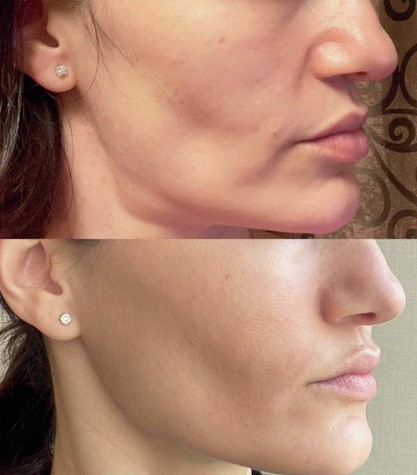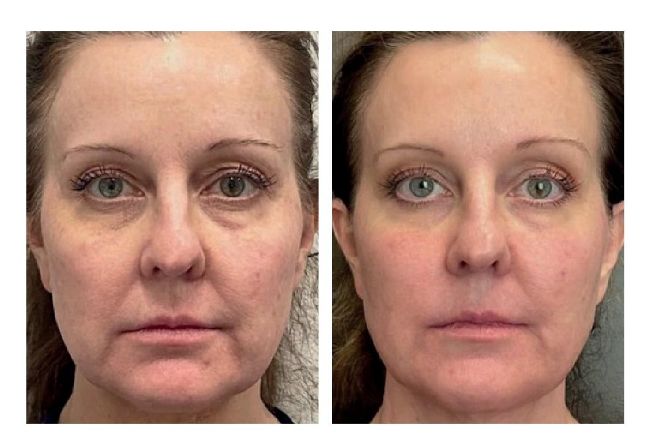clinical
Ultrasound for skin-tightening
Dr Sindhu Siddiqi considers the benefit of incorporating ultrasound into your skin tightening treatments
DR SINDHU SIDDIQI
Focused on undetectable treatments and subtle tweaks, Dr Sindhu Siddiqi has been a doctor since 2011 and graduated from the prestigious Imperial College London with a distinction in Medicine. She undertook extensive training in aesthetic medicine alongside her GP training and built her aesthetics clinic in a completely organic way through word-of-mouth referrals. No Filter Clinic focuses on skin, bio-regenerative medicine, and injectables, offering an expertly tailored approach to their treatment plans.
Skin tightening devices have gained a lot of popularity in recent years for their effective results with or without injectables. There are several machines available on the market and understanding the key differences is important for deciding which machine to invest in and which one will be most suited to your patients. The most problematic areas people complain of in-clinic are the lower face and jowl area, the periorbital area, and the submental region.
HOW DO SKIN-TIGHTENING DEVICES WORK
The basic premise of all skin tightening machines is delivering heat to the skin and underlying structures. This leads to the contraction of the collagen fibres by the breakdown of the intermolecular bonds between protein chains within collagen fibres. Collagen is a triple helix structure, and the breaking of these bonds leads to the formation of thicker and shorter collagen fibres. This results in an immediate tightening effect. There is also a secondary process whereby the thermal injury leads to new collagen formation via the wound-healing response. Research has shown that the optimal temperature is somewhere between 57-61 degrees Celsius for this process to happen. However, you can get good results with lower temperatures but longer exposure to the heat is needed for equivalent results. This is why treatments with certain machines require multiple sessions, as they deliver less heat. The benefit of such machines is that they are easier to tolerate for patients, but it takes them longer to see the results.1
If the temperature is too high, the incorrect depth is used, or the patient selection has not been appropriate, energy-based devices can lead to complete denaturing of collagen fibres. There are reported cases of people feeling they aged or looked worse after having energy-based treatments, so although the machines are safe, patient selection, and using the correct machine with the correct settings is important.

Before and after
WHICH DEPTH DO YOU WANT TO TARGET
The depth targeted with skin tightening devices is critical in understanding the outcome. Research has shown that the average thickness of the skin (epidermis and dermis) is between 1.1- 1.7 mm.2 Beyond this is the subcutaneous fat and then the superficial musculoaponeurotic system (SMAS) layer. Lasers generally target the surface layers of the skin which improves skin texture, fine lines, scars and luminosity. If you target the epidermis and dermis you should get more deeper contraction of collagen fibrils and tissue tightening with lifting. Targeting subcutaneous fat can be desirable in some patients and not in others. Although in plastic surgery SMAS is the layer targeted, to reach this layer you have to go through the risk of fat atrophy.3 The machine you use determines which layer you will target.4
TYPES OF SKIN TIGHTENING MACHINES
Ablative skin lasers were previously deemed the gold standard for skin tightening but they come with significantly more downtime and a higher risk of side effects such as hyperpigmentation compared to the newer ultrasound, radiofrequency and even radiofrequency combined with micro-needling machines. Ablative lasers also do not reach the required depth to reach the dermis and are better for skin resurfacing and scarring. CO2 lasers reach on average a depth of 0.02 to 0.03 mm with a maximum of around 0.07 mm.5 You still do get a skin tightening effect, but the result is limited to the surface layer which may be sufficient for some patients but not all.
HIFU/MFU
With the advances in aesthetic medicines, newer technology with less downtime arrived on the market. One such early technology is High intensity Focused Ultrasound or HIFU as it is more commonly known. Research has consistently shown HIFU improves skin laxity, and rejuvenation and can have a lifting effect.6-8 The depth of the HIFU beams determines the target area and the machines usually have different depths ranging from 1.5- 4.5 mm. The ultrasound beams with HIFU travel perpendicular to the skin and the actual treatment depth is dependent on the patient’s skin and tissue thickness. We know this can vary significantly between people and also within a patient in different parts of their face. If the depth is deeper than intended, it can have unfavourable consequences and lead to nerve injury or fat atrophy. This can be particularly unfavourable in the midface or brow area. Although HIFU is considered a safe technology it is very user dependent and there is always a small risk of fat loss with slim patients. This could be desirable for people wanting to slim the submental area or for body contouring, but it is generally not desirable in the midface, buccal or brow area. Micro-focused ultrasound is another type of skin tightening where the beams are more focused than HIFU. While it can be very effective and side effects are rare, if they occur, they can be serious and long term such as cutaneous necrosis.9 Overall HIFU and MFU devices are very user dependent and the results and safety both rely on the operator heavily.
RADIOFREQUENCY AND FRACTIONAL RADIOFREQUENCY WITH MICRONEEDLING
Radiofrequency machines have become very popular in recent years. They generally reach a lower target temperature than Ultrasound machines (around 45 degrees vs 60 degrees) and are usually less painful as a result.10 However, they need more sessions than HIFU/MFU devices to see similar results.
Fractional radiofrequency with micro-needling has become very popular and is very useful in controlling the depth of the treatment which reduces side effects. Radiofrequency delivered via micro-needling is more effective than radiofrequency alone and can be comparable to HIFU/MFU. However, there is downtime with this which can put people off getting this treatment. 11
We saw excellent results from fractional radiofrequency in our clinic, but it was time to look for something that did not have the downtime associated with it. Our clients are mainly busy and active professionals who want to be able to go back to work and socialise the next day. This is where Sofwave comes in.
SOFWAVE
Sofwave is the latest technology on the market, that utilises ultrasound waves, but they are delivered in a very different way to other ultrasound machines. It uses synchronous parallel beam ultrasound technology where the waves penetrate the skin and converge in cylindrical-shaped thermal zones parallel to the skin. The beams converge at a depth of around 1.5 mm.12 This means it targets the average thickness of the epidermis and dermis without any risk of harm to the fat layer, nerves, or bone. There is cooling of the skin which reduces the risk of superficial burns and post-inflammatory hyperpigmentation (PIH). The energy is delivered uniformly and in a controlled fashion. The main benefits of Sofwave over other technologies are no down time and a better safety profile. It has published data behind it and has been FDA-approved for brow lift, wrinkle reduction, cellulite and more recently, acne scarring. I liked that it had no risk of hyperpigmentation and no trauma to the skin. The other reason I like this device is that it is much easier to combine with injectable treatments in a shorter period as there is little downtime. I tend to do injectables from two weeks after the treatment and as with all combination treatments, the results are synergistic and much more efficacious. We have our unique protocol for the neck at the clinic where we combine Sofwave with bioregenerative injectables and have seen fantastic results.

Before and after
As with any machine, patient selection is important. Patients with a high body mass index (BMI) or significant submental fat or excess skin may not see as much of a difference with Sofwave compared to HIFU/MFU machines.
WHO IS THE IDEAL PATIENT
Skin tightening results can be variable as they rely on each individual’s ability to regenerate collagen. Everyone will have some tightening but if it is very subtle, patients will not notice it. The list below is the ideal patient from personal experience and published research. It is not comprehensive and there will always be people that respond better and worse than expected.
1. Normal BMI
2. No significant excess skin in eyelid and jawline area
3. Mild to moderate laxity especially eyelid and jawline
4. Neck wrinkles/textured skin
5. Age under 60. Over 60 can get a good result if reasonable skin quality and no significant elastosis.
6. Reasonable pain threshold. The more powerful the device the more painful it is.
7. Realistic expectations.
HOW TO DECIDE WHICH MACHINE
I spent a lot of time researching which machines to have in the clinic. Ultimately, it depends on many factors and it comes down to the combination that suits your clinic and your patient base. These are some things to think about.
1. Efficacy and Safety data. Does it have any FDA approvals?
2. Do you have many darker-skinned patients? Look at safety data for people of colour as they suffer from the risks of post-inflammatory hyperpigmentation more.
3. Are your patients mainly slim and fit young professionals? They will not want anything with a risk of fat loss.
4. Can your aesthetician operate the machine, or does it have to be a clinician?
5. How much time does the training take and how easy is it to get it standardised?
6. Are your parents able to come for multiple treatments, are they local or do they come from all over the place?
7. What is an affordable price range for your client base?
8. How much downtime does your average patient tolerate?
9. Do you have the capacity and systems in place to deal with complications if taking on a higher-risk machine such as an ablative laser?
10. How many other clinics in the area have the same machine? Who are you competing with in this saturated market?
11. What kind of online presence and branding does the machine have? It is always easier to sell something the patients can look up easily.